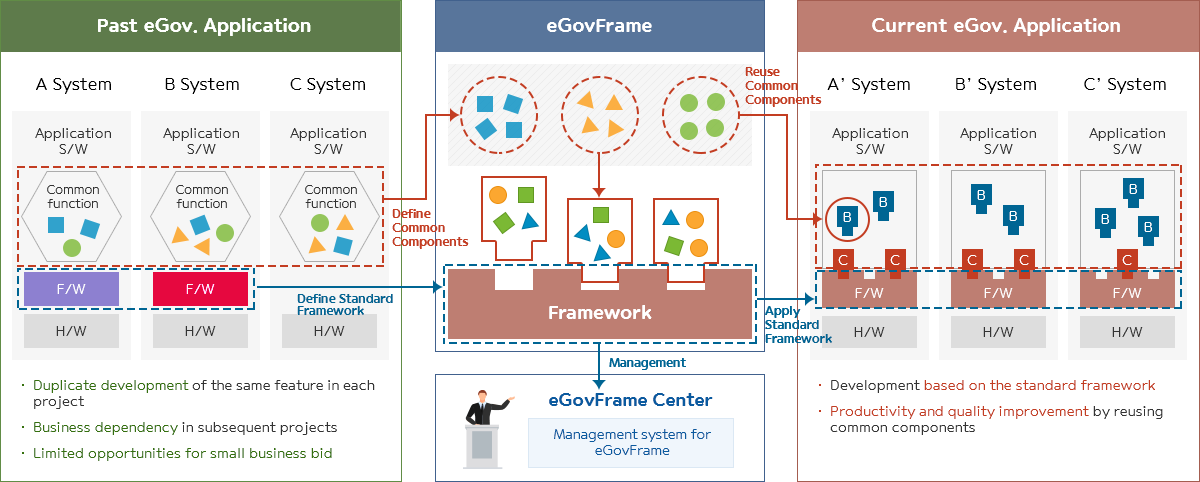Skip to main content Skip to main menu
eGovFrame Introduction
Provides the brief introduction on the eGovernment Standard Framework.
PRINT HOME EGOVFRAME Introduction
Introduction of The eGovernment Standard Framework
is a platform-specific standardized development framework for public sector IT projects in Korea.
It is developed by the government of the Republic of Korea and
can be used by every person all over the world."
Vision & Objectives
The eGovernment Standard Framework is an infrastructure environment for implementing application SWs and provides basic functions in the application SW runtime. The eGovernment Standard Framework has an objective to increase the quality of eGovernment services, the efficiency of IT investment and the standardization and the reusability of application SWs through establishing and applying the development framework standard.
Vision
Improve service quality of e-Government & efficiency of ICT investment
Objectives
- Reuse common features
- Increase Interoperability
- Reflect Iatest ICT trends
- Resolve vendor dependency
- Enhance SMEs competitiveness
Strategies
-
Standardization
- Establish SW framework standards for e-Government
- Provide reliable technology infrastructure
-
Openness
- Approve the general use of eGovFrame
- Open assets to the public & encourage participation
-
Community
- Propagete eGovFrame through the regular training
- Draw up a policy to vitalize eGovFrame
Background
There are many problems in the existing eGovernment system because each individual application system uses various kinds and versions of frameworks. The development frameworks used in the existing eGovernment system are hard to maintain without vendor's technical support because they are provided as Black Box modules, and so have specific vendor dependency. In case of systems on which multiple development frameworks are applied, the definition of development standards, the supply of developers and the education for each framework lead to redundant investments and it is hard to manage the versions even in a single development framework due to the incompleteness of the systematic management procedure for the framework. The standardization of eGovernment Framework eliminates the technical dependency on vendor's proprietary development framework, promotes the standardization, and so increases the quality and reusability, of application SWs, increases the investment efficiency through the unification of development framework maintenance.

Features
The eGovernment Standard Framework has following features to accomplish its objective to increase the interoperability and the reusability of National Information Systems.
- Complies with open standards
- - Uses open and widely used technologies instead of proprietary technologies
- - Eliminates the dependency on a specific vendors by using open source based technologies
- Integrates with commercial solutions
- - Assures interoperability by providing standards for integrating with commercial solutions
- - Provides interchangeable structures which are not dependent on specific solutions
- Oriented towards standardization on the national scale
- - Holds advisory meetings of public officials, professors and solution and SI vendors
- - Performs standardization on the national scale through persistent opinion gathering and information exchange
- Flexible to cope with the newest technologies
- - Structured to exchange modules easily to cope with the progress of technologies
- - Loose coupling between modules through interface-based integration
- Provides easy to use and function-rich environments
- - Provides convenient Editing, Compiling and Debugging environment through an Eclipse-based development environment
- - Provides functions for the UML and ERD modeling
- - Provides convenient data processing functions using DBIO
Benefits
The eGovernment Standard Framework increases development productivity and component reusability among application systems by providing a standardized infrastructure, increases the interoperability and promotes the standardization of application SWs through the interface standards.
- Increase in development productivity
- Minimizes redundant developments by providing common essential functions and allows developers to concentrate on the business logic by defining an infrastructure.
- Increase in the reusability of eGovernment application systems
- Increase the standardization of the development framework allows components already developed on the eGovernment Standard Framework to be reused in other application systems.
- Increase in the interoperability of the eGovernment systems
- Increase the interoperability of application systems by using standard inter-system integration interface.
- Standardization of eGovernment application systems
- Promotes the standardization of the program code by providing the standardized development infrastructure for presentation, business logic processing and data processing.
- Promotion of open source SW use
- Promotes the developer's use of open source SWs by defining open source based standard framework.
- Improvements in the competitiveness of SM-sized SW vendors
- Strengthens the competitiveness of SM-sized SW vendors by sharing the eGovernment Standard Framework and increasing development manpower skillful in developing on the framework.
